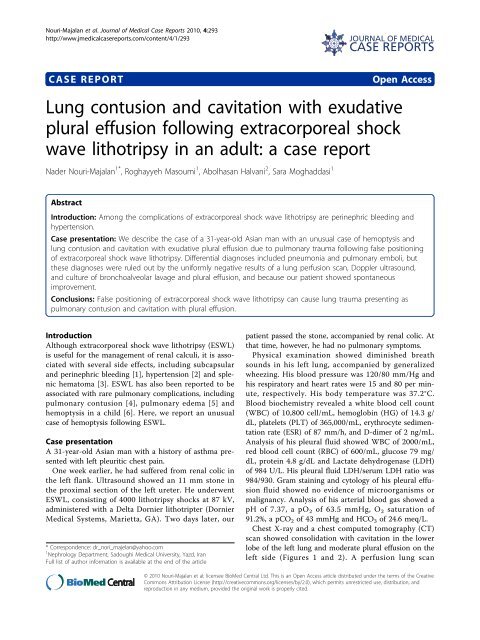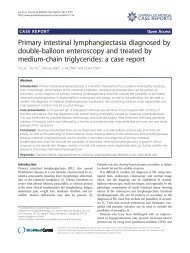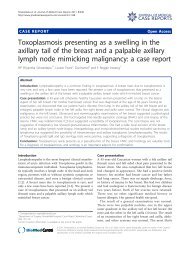Lung contusion and cavitation with exudative plural effusion ...
Lung contusion and cavitation with exudative plural effusion ...
Lung contusion and cavitation with exudative plural effusion ...
You also want an ePaper? Increase the reach of your titles
YUMPU automatically turns print PDFs into web optimized ePapers that Google loves.
Nouri-Majalan et al. Journal of Medical Case Reports 2010, 4:293<br />
http://www.jmedicalcasereports.com/content/4/1/293 JOURNAL OF MEDICAL<br />
CASE REPORTS<br />
CASE REPORT Open Access<br />
<strong>Lung</strong> <strong>contusion</strong> <strong>and</strong> <strong>cavitation</strong> <strong>with</strong> <strong>exudative</strong><br />
<strong>plural</strong> <strong>effusion</strong> following extracorporeal shock<br />
wave lithotripsy in an adult: a case report<br />
Nader Nouri-Majalan 1* , Roghayyeh Masoumi 1 , Abolhasan Halvani 2 , Sara Moghaddasi 1<br />
Abstract<br />
Introduction: Among the complications of extracorporeal shock wave lithotripsy are perinephric bleeding <strong>and</strong><br />
hypertension.<br />
Case presentation: We describe the case of a 31-year-old Asian man <strong>with</strong> an unusual case of hemoptysis <strong>and</strong><br />
lung <strong>contusion</strong> <strong>and</strong> <strong>cavitation</strong> <strong>with</strong> <strong>exudative</strong> <strong>plural</strong> <strong>effusion</strong> due to pulmonary trauma following false positioning<br />
of extracorporeal shock wave lithotripsy. Differential diagnoses included pneumonia <strong>and</strong> pulmonary emboli, but<br />
these diagnoses were ruled out by the uniformly negative results of a lung perfusion scan, Doppler ultrasound,<br />
<strong>and</strong> culture of bronchoalveolar lavage <strong>and</strong> <strong>plural</strong> <strong>effusion</strong>, <strong>and</strong> because our patient showed spontaneous<br />
improvement.<br />
Conclusions: False positioning of extracorporeal shock wave lithotripsy can cause lung trauma presenting as<br />
pulmonary <strong>contusion</strong> <strong>and</strong> <strong>cavitation</strong> <strong>with</strong> <strong>plural</strong> <strong>effusion</strong>.<br />
Introduction<br />
Although extracorporeal shock wave lithotripsy (ESWL)<br />
is useful for the management of renal calculi, it is associated<br />
<strong>with</strong> several side effects, including subcapsular<br />
<strong>and</strong> perinephric bleeding [1], hypertension [2] <strong>and</strong> splenic<br />
hematoma [3]. ESWL has also been reported to be<br />
associated <strong>with</strong> rare pulmonary complications, including<br />
pulmonary <strong>contusion</strong> [4], pulmonary edema [5] <strong>and</strong><br />
hemoptysis in a child [6]. Here, we report an unusual<br />
case of hemoptysis following ESWL.<br />
Case presentation<br />
A 31-year-old Asian man <strong>with</strong> a history of asthma presented<br />
<strong>with</strong> left pleuritic chest pain.<br />
One week earlier, he had suffered from renal colic in<br />
the left flank. Ultrasound showed an 11 mm stone in<br />
the proximal section of the left ureter. He underwent<br />
ESWL, consisting of 4000 lithotripsy shocks at 87 kV,<br />
administered <strong>with</strong> a Delta Dornier lithotripter (Dornier<br />
Medical Systems, Marietta, GA). Two days later, our<br />
* Correspondence: dr_nori_majelan@yahoo.com<br />
1 Nephrology Department, Sadoughi Medical University, Yazd, Iran<br />
Full list of author information is available at the end of the article<br />
patient passed the stone, accompanied by renal colic. At<br />
that time, however, he had no pulmonary symptoms.<br />
Physical examination showed diminished breath<br />
sounds in his left lung, accompanied by generalized<br />
wheezing. His blood pressure was 120/80 mm/Hg <strong>and</strong><br />
his respiratory <strong>and</strong> heart rates were 15 <strong>and</strong> 80 per minute,<br />
respectively. His body temperature was 37.2°C.<br />
Blood biochemistry revealed a white blood cell count<br />
(WBC) of 10,800 cell/mL, hemoglobin (HG) of 14.3 g/<br />
dL, platelets (PLT) of 365,000/mL, erythrocyte sedimentation<br />
rate (ESR) of 87 mm/h, <strong>and</strong> D-dimer of 2 ng/mL.<br />
Analysis of his pleural fluid showed WBC of 2000/mL,<br />
red blood cell count (RBC) of 600/mL, glucose 79 mg/<br />
dL, protein 4.8 g/dL <strong>and</strong> Lactate dehydrogenase (LDH)<br />
of 984 U/L. His pleural fluid LDH/serum LDH ratio was<br />
984/930. Gram staining <strong>and</strong> cytology of his pleural <strong>effusion</strong><br />
fluid showed no evidence of microorganisms or<br />
malignancy. Analysis of his arterial blood gas showed a<br />
pH of 7.37, a pO 2 of 63.5 mmHg, O 2 saturation of<br />
91.2%, a pCO 2 of 43 mmHg <strong>and</strong> HCO 3 of 24.6 meq/L.<br />
Chest X-ray <strong>and</strong> a chest computed tomography (CT)<br />
scan showed consolidation <strong>with</strong> <strong>cavitation</strong> in the lower<br />
lobe of the left lung <strong>and</strong> moderate <strong>plural</strong> <strong>effusion</strong> on the<br />
left side (Figures 1 <strong>and</strong> 2). A perfusion lung scan<br />
© 2010 Nouri-Majalan et al; licensee BioMed Central Ltd. This is an Open Access article distributed under the terms of the Creative<br />
Commons Attribution License (http://creativecommons.org/licenses/by/2.0), which permits unrestricted use, distribution, <strong>and</strong><br />
reproduction in any medium, provided the original work is properly cited.
Nouri-Majalan et al. Journal of Medical Case Reports 2010, 4:293<br />
http://www.jmedicalcasereports.com/content/4/1/293<br />
Figure 1 Chest X-ray showing consolidation in the lower lobe<br />
of the left lung.<br />
revealed decreased perfusion in the subsegment of the<br />
left lung, indicating a low probability of pulmonary<br />
emboli. Lower extremity venous ultrasound showed no<br />
evidence of thrombosis. Culture of bronchoalveolar<br />
lavage (BAL) samples showed no evidence of<br />
microorganisms.<br />
Our patient was treated <strong>with</strong> antibiotics <strong>and</strong> heparin<br />
for two days. After obtaining BAL culture <strong>and</strong> lung scan<br />
results, however, treatment was discontinued. He recovered<br />
spontaneously after four days.<br />
Discussion<br />
To the best of our knowledge, this is the first report in<br />
an adult of pulmonary <strong>contusion</strong> <strong>and</strong> <strong>cavitation</strong> <strong>with</strong><br />
<strong>exudative</strong> <strong>plural</strong> <strong>effusion</strong> due to lung trauma following<br />
false positioning of ESWL. Differential diagnoses<br />
included pneumonia <strong>and</strong> pulmonary emboli, but these<br />
diagnoses were ruled out because the results of lung<br />
perfusion scan, Doppler ultrasound, <strong>and</strong> culture of BAL<br />
<strong>and</strong> <strong>plural</strong> <strong>effusion</strong> were all negative, <strong>and</strong> because our<br />
patient showed spontaneous improvement.<br />
Although hemoptysis following ESWL usually starts<br />
during or shortly after the procedure [4,6], our patient<br />
Figure 2 CT scan showing left lower lobe consolidation <strong>with</strong><br />
<strong>cavitation</strong> <strong>and</strong> moderate pleural <strong>effusion</strong>.<br />
first showed evidence of hemoptysis one week after<br />
ESWL. Chest radiography <strong>and</strong> CT scan showed lung<br />
consolidation <strong>with</strong> <strong>cavitation</strong> <strong>and</strong> pleural <strong>effusion</strong>; in<br />
previous patients, chest X-rays were normal [7] or<br />
showed only lung <strong>contusion</strong> [4]. Two children <strong>with</strong><br />
lithotripsy-induced pulmonary <strong>contusion</strong> <strong>and</strong> hemoptysis<br />
have been described [4-7]. Due to their smaller body<br />
surface area <strong>and</strong> the shorter distance between the lung<br />
base <strong>and</strong> the kidney, the likelihood of pulmonary trauma<br />
following ESWL may be higher in children than in<br />
adults [8].<br />
Pulmonary <strong>contusion</strong> following ESWL has also been<br />
shown experimentally in mice [9]. At the microscopic<br />
level, shock waves have been shown to cause trauma in<br />
pneumocytes <strong>and</strong> endothelial cells, resulting in a direct<br />
communication between the lumina of vessels <strong>and</strong><br />
alveolar spaces, ultimately leading to hemoptysis [10].<br />
Life threatening hypoxemia following ESWL has also<br />
been reported [11]. Our patient, however, had moderate<br />
hypoxemia.<br />
Conclusions<br />
False positioning of ESWL can cause lung trauma presenting<br />
as pulmonary <strong>contusion</strong> <strong>and</strong> <strong>cavitation</strong> <strong>with</strong><br />
<strong>plural</strong> <strong>effusion</strong>.<br />
Competing interests<br />
The authors declare that they have no competing interests.<br />
Authors’ contributions<br />
NN was primarily responsible for the diagnosis <strong>and</strong> management of the<br />
patient, drafting of the manuscript, literature search, <strong>and</strong> submission <strong>and</strong><br />
revision of the manuscript. RM <strong>and</strong> SM were responsible for drafting of the<br />
manuscript <strong>and</strong> literature search. AH was responsible for the diagnosis <strong>and</strong><br />
management of the patient. All authors have read <strong>and</strong> approved the final<br />
manuscript.<br />
Consent<br />
Written informed consent was obtained from the patient for publication of<br />
this case report <strong>and</strong> any accompanying images. A copy of the written<br />
consent form is available for review by the Editor-in-Chief of this journal.<br />
Acknowledgements<br />
The authors thank nurses for their cooperation.<br />
Author details<br />
1 Nephrology Department, Sadoughi Medical University, Yazd, Iran.<br />
2 Pulmonary Department, Sadoughi Medical University, Yazd, Iran.<br />
Received: 30 October 2009 Accepted: 31 August 2010<br />
Published: 31 August 2010<br />
Page 2 of 3<br />
References<br />
1. Dar NB, Thornton J, Karafa MT, Streem SB: A multivariate analysis of risk<br />
factors associated <strong>with</strong> subcapsular hematoma formation following<br />
electromagnetic shock wave lithotripsy. J Urol 2004, 172:2271-2274.<br />
2. Lingeman JE, Woods JR, Toth PD: Blood pressure changes following<br />
extracorporeal shock wave lithotripsy <strong>and</strong> other forms of treatment for<br />
nephrolithiasis. JAMA 1990, 263:1789-1794.<br />
3. Conde Redondo C, Estebanez Zarranz J, Amon Sesmero J, Manzanas M,<br />
Alonso Fern<strong>and</strong>ez D, Rodriguez Toves LA, Martinez Sagarra JM: Splenic
Nouri-Majalan et al. Journal of Medical Case Reports 2010, 4:293<br />
http://www.jmedicalcasereports.com/content/4/1/293<br />
hematoma after extracorporeal lithotripsy: apropos of a case. Arch Esp<br />
Urol 2002, 55:943-946.<br />
4. Tiede JM, Lumpkin EN, Wass CT, Long TR: Hemoptysis following<br />
extracorporeal shock wave lithotripsy: a case of lithotripsy-induced<br />
pulmonary <strong>contusion</strong> in a pediatric patient. J Clin Anesth 2003,<br />
15:530-533.<br />
5. Wulfson HD, LaPorta RF: Pulmonary edema after lithotripsy in a patient<br />
<strong>with</strong> hypertrophic subaortic stenosis. Can J Anaesth 1993, 40:465-467.<br />
6. Malhotra V, Gomillion MC, Artusio JF Jr: Hemoptysis in a child during<br />
extracorporeal shock wave lithotripsy. Anesth Analg 1989, 69:526-528.<br />
7. Sigman M, Laudone VP, Jenkins AD, Howards SS, Riehle R Jr, Keating MA,<br />
Walker RD: Initial experience <strong>with</strong> extracorporeal shock wave lithotripsy<br />
in children. J Urol 1987, 138:839-841.<br />
8. Tredrea CR, Pathak D, From RP, Grucza J: <strong>Lung</strong> protection in children<br />
during extracorporeal shockwave lithotripsy. Anesth Analg 1987, 66:S178.<br />
9. Chen H, Wang Z, Ning X, Xu H, Xiao K: Animal study on lung injury<br />
caused by stimulant segmented shock waves. Chin J Traumatol 2001,<br />
4:37-39.<br />
10. Penney DP, Schenk EA, Maltby K, Hartman-Raeman C, Child SZ,<br />
Carstensen EL: Morphological effects of pulsed ultrasound in the lung.<br />
Ultrasound Med Biol 1993, 19:127-135.<br />
11. Malhotra V, Rosen RJ, Slepian RL: Life-threatening hypoxemia after<br />
lithotripsy in an adult due to shock-wave-induced pulmonary <strong>contusion</strong>.<br />
Anesthesiology 1991, 75:529-531.<br />
doi:10.1186/1752-1947-4-293<br />
Cite this article as: Nouri-Majalan et al.: <strong>Lung</strong> <strong>contusion</strong> <strong>and</strong> <strong>cavitation</strong><br />
<strong>with</strong> <strong>exudative</strong> <strong>plural</strong> <strong>effusion</strong> following extracorporeal shock wave<br />
lithotripsy in an adult: a case report. Journal of Medical Case Reports 2010<br />
4:293.<br />
Submit your next manuscript to BioMed Central<br />
<strong>and</strong> take full advantage of:<br />
• Convenient online submission<br />
• Thorough peer review<br />
• No space constraints or color figure charges<br />
• Immediate publication on acceptance<br />
• Inclusion in PubMed, CAS, Scopus <strong>and</strong> Google Scholar<br />
• Research which is freely available for redistribution<br />
Submit your manuscript at<br />
www.biomedcentral.com/submit<br />
Page 3 of 3








